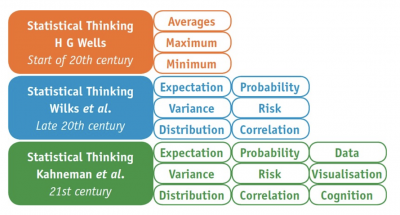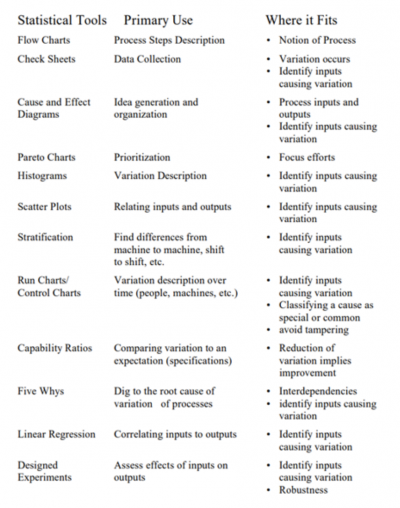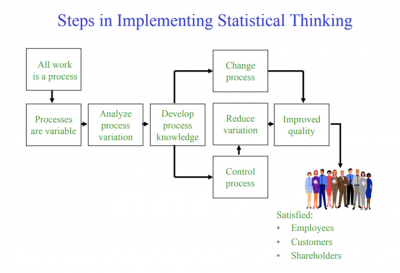
In today’s business world, we hear a number of concepts tossed around, such as “big data,” data analysis, process thinking, data-driven decision-making, and statistical thinking. Statistical thinking is more of a business philosophy than a set of statistical methods and tools according to Peter Daisley.
We will present the evolution of statistical thinking, its conceptual foundation, and why it is important for your organization.
Overview: What is statistical thinking?
The American Society of Quality (ASQ) defines statistical thinking as a philosophy of learning and action that seeks to relate process thinking with statistics and is based on the following fundamental principles:
- All work occurs in a system of interconnected processes.
- Variation exists in all processes.
- Understanding and reducing variation are the keys to success.
The history of statistical thinking goes back to Well’s 1903 statement:
“The great body of physical science … [is] only accessible and only thinkable to those who have had a sound training in mathematical analysis, and the time may not be very remote when it will be understood that for complete initiation as an efficient citizen … it is necessary to be able to compute, to think in averages and maxima and minima, as it is now to be able to read and write.”
Renowned consultant Dr. Ron Snee talked about the concepts of statistical thinking and defined statistical thinking in 1986 as “thought processes,” not formulas. He made the distinction between statistical thinking and statistical methods. In 2002, Snee published an introductory business statistics textbook based on statistical thinking entitled Statistical Thinking: Improving Business Performance.
Although famed statistician and consultant Dr. W. Edwards Deming didn’t use the phrase statistical thinking, he did talk about statistical concepts. Beginning in 1987, one of Deming’s students, Heero Hacquebord, presented public statistical thinking courses emphasizing the managerial implications of statistical concepts.
With the development of Six Sigma, the statistical thinking principles of process, variation, and the reduction of variation came together in the DMAIC methodology. Nobel Prize winner Daniel Kahneman examined the ability of people to think statistically in his 2012 book Thinking, Fast and Slow. Below is a graphic summarizing the evolution of statistical thinking.

Image source: rss.onlinelibrary.wiley.com.
While the term “statistical thinking” refers to a philosophy of thinking and managing, there are a number of statistical tools linked to the principles that can be used. The list below shows a few of them.

Image source: www.stat.auckland.ac.nz
The following graphic describes the relationship between the statistical tools and the principles of statistical thinking.

Image source: asq.org.
3 benefits of statistical thinking
Applying statistical thinking and statistical methods is a powerful strategy for improving your organization.
1. Focus on the process
All work is a process. We can define a process as a series of steps, activities and tasks that take inputs and transform them into outputs. Focusing on your processes will give you insights into possible opportunities for improvement.
2. Reduction of process variation
All processes vary. Understanding the source of your variation (Common or Special Cause) and the appropriate actions to reduce it will result in more efficient processes and improved customer satisfaction
3. Decisions based on data not intuition
Thinking in terms of process, variation, and statistics will allow you to make data-driven decisions instead of subjective and intuitive ones. This should lead you to more objective and fact-based actions.
Why is statistical thinking important to understand?
As the business world moves from relying purely on intuition to make decisions, you need to understand the concepts of statistical thinking to make better data-driven decisions.
Focus is on the process
Everything you do can be thought of as a process. That process will exhibit variation, which can be reduced and present opportunities for improving everything you do.
Merging of process thinking with statistical methodology
Statistics by itself never improves a process. By combining statistical tools and methodologies with process thinking, you get a robust and powerful way to look at what you do.
Way of thinking
The foundation of statistical thinking is built upon having statistical knowledge, context knowledge, and the information in data. Statistical thinking is the synthesis of these elements that provides implications, insights, and conjectures to make your process decisions.
An industry example of statistical thinking
Ted, a Green Belt (GB) candidate at a large glass-making site, had just started on his project. He chose his project based on comments from the manager in the autoclave department. The manager was convinced that glass breakage had increased because of the crowding of racks in the area. More racks led to more movement, which led to racks bumping into each other, resulting in broken glass panels. Ted’s manager approved the project.
Ted started his project by doing a process map of the autoclave process. Then he collected data on the number of racks in the area per day and the corresponding breakage. Kendra, his Master Black Belt (MBB) coach, suggested that he run a control chart and do a simple linear regression of the number of racks versus breakage.
Much to Ted’s surprise, the control chart showed the process was in statistical control and exhibiting common cause variation. The regression showed there was no correlation between the number of racks in the autoclave area and glass breakage. Kendra pointed out to Ted that intuition is not the best way to select projects. By using statistical thinking, Ted was able to demonstrate to the autoclave manager that breakage was not due to the number of racks in the area.
3 best practices when thinking about statistical thinking
Integrating process and statistical knowledge will provide you a framework for thinking differently about what you do.
1. Map your process
The first step in statistical thinking is to map your current state process. This is a graphical description of the as-is actual process that exists, not what you want it to be or think it is.
2. Validate your data
Can you trust your data? Not until you do Measurement System Analysis (MSA) to confirm that your data collection system is capable of reporting precise, consistent, and accurate data.
3. Let the data speak
The goal of statistical thinking is to make decisions based on data, not just intuition or heuristics. If you select the correct statistical tools for analysis of your data, base your decisions on the outcomes of your analysis, and temper it by some subjectivity of the actual context and business environment, you will make better business decisions.
Frequently Asked Questions (FAQ) about statistical thinking
What are the basic principles of statistical thinking?
All work is accomplished in a system of interconnected processes that exhibit variation with the goal of reducing the variation. It is the synthesis of process and statistical methodology.
Who said, “Statistical thinking will one day be as necessary for efficient citizenship as the ability to read and write.”
Famed author H.G. Wells has been credited with writing this statement.
Is statistical thinking the same as statistics?
No. Statistical thinking is a philosophy of understanding what you do in your organization. It focuses on understanding your processes, their variation, and how to reduce that variation. Statistical tools and methods are part of statistical thinking but not the core of what it is.
Thinking about statistical thinking
Statistical thinking is based on three concepts: all work consists of interconnected processes, all processes have variation, and variation can be reduced. By combining process thinking with statistical methodologies, you will be able to make better data-driven decisions and not have to rely on subjective intuition as your source for decision-making.